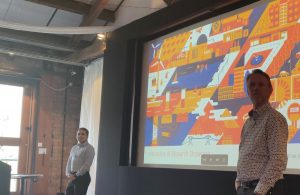Blog post written by CDT Student Oli Deane.
This year’s IAI CDT Research Showcase represented the first real opportunity to bring the entire CDT together in the real world, permitting in-person talks and face-to-face meetings with industry partners.
Student Presentations

The day began with a series of quickfire talks from current CDT students. Presentations had a different feel this year as they followed a Pecha Kucha style; speakers had ~6 minutes to present their research with individual slides automatically progressing after 20 seconds. As a result, listeners received a whistle-stop tour of each project without delving into the nitty gritty details of research methodologies.
Indeed, this quickfire approach highlighted the sheer diversity of projects carried out in the CDT. The presented projects had a bit of everything; from a data set for analyzing great ape behaviors, to classification models that determine dementia progression from time-series data.
It was fascinating to see how students incorporated interactivity into project designs. Grant Stevens, for example, uses active learning and outlier detection methods to classify astronomical phenomena. Tashi Namgyal has developed MIDI-DRAW, an interactive musical platform that permits the curation of short musical samples with user-provided hand-drawn lines and pictures. Meanwhile, Vanessa Hanschke is collaborating with LV to explore how better ethical practices can be incorporated into the data science workflow; for example, her current work explores an ethical ‘Fire-drill’ – a framework of emergency responses to be deployed in response to the identification of problematic features in existing data-sets/procedures. This is, however, just the tip of the research iceberg and I encourage readers to check out all ongoing projects on the IAI CDT website.
Industry Partners

Next, representatives from three of our industry partners presented overviews of their work and their general involvement with the CDT.
First up was Dylan Rees, a Senior Data Engineer at LV. With a data science team stationed in MVB at the University of Bristol, LV are heavily involved with the university’s research. As well as working with Vanessa to develop ethical practices in data science, they run a cross-CDT datathon in which students battle to produce optimal models for predicting fair insurance quotes. Rees emphasized that LV want responsible AI to be at the core of what they do, highlighting how insurance is a key example of how developments in transparent, and interactive, AI are crucial for the successful deployment of AI technologies. Rees closed his talk with a call to action: the LV team are open to, and eager for, any collaboration with UoB students – whether it be to assist with data projects or act as “guinea pigs” for advancing research on responsible AI in industry.
Gustavo Vasquez from EDF Energy then discussed their work in the field and outlined some examples of past collaborations with the CDT. They are exploring how interactive AI methods can assist in the development and maintenance of green practices – for example, one ongoing project uses computer vision to identify faults in wind turbines. EDF previously collaborated with members of the CDT 2019 cohort as they worked on an interactive search-based mini project.
Finally, Dr. Claire Taylor, a representative from QINETIQ, highlighted how interactive approaches are a major focus of much of their research. QINETIC develop AI-driven technologies in a diverse range of sectors: from defense to law enforcement, aviation to financial services. Dr. Taylor discussed the changing trends in AI, outlining how previously fashionable methods that have lost focus in recent years are making a come-back courtesy of the AI world’s recognition that we need more interpretable, and less compute-intensive, solutions. QINETIQ also sponsor Kevin Flannagan’s (CDT 2020 cohort) PhD project in which he explores the intersection between language and vision, creating models which ground words and sentences within corresponding videos.
Academic Partners and Poster Session

To close out the day’s presentations, our academic partners discussed their relevant research. Dr. Oliver Ray first spoke of his work in Inductive Logic Programming before Dr. Paul Marshall gave a perspective from the world of human computer interaction, outlining a collaborative cross-discipline project that developed user-focused technologies for the healthcare sector.
Finally, a poster session rounded off proceedings; a studious buzz filled the conference hall as partners, students and lecturers alike discussed ongoing projects, questioning existing methods and brainstorming potential future directions.
In all, this was a fantastic day of talks, demonstrations, and general AI chat. It was an exciting opportunity to discuss real research with industry partners and I’m sure it has produced fruitful collaborations.
I would like to end this post with a special thank you to Peter Relph and Nikki Horrobin who will be leaving the CDT for bigger and better things. We thank them for their relentless and frankly spectacular efforts in organizing CDT events and responding to students’ concerns and questions. You will both be sorely missed, and we all wish you the very best of luck with your future endeavors!
